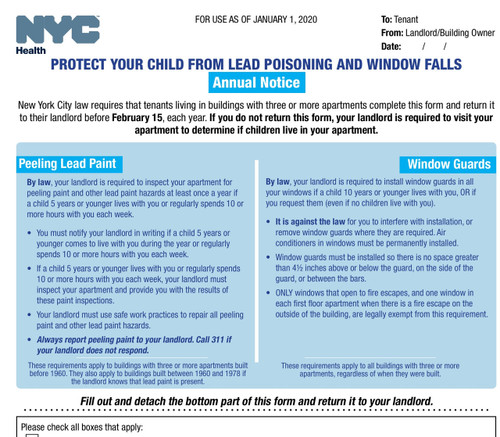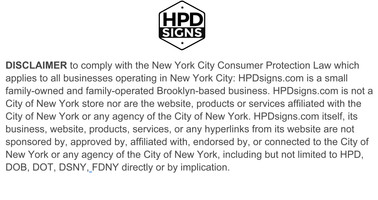Windows guard and lead paint notice 2020 English/ Spanish (pdf file)
- Availability:
- USUALLY SHIP WITH IN 1-2 BUSINESS DAY
Description
The New York City Department of Housing Preservation and Development (HPD) requires landlords and property managers to provide tenants with annual notices on lead poisoning prevention and window fall prevention. This guide details the process to ensure compliance and protect tenants, particularly those with young children, from lead exposure and window-related accidents. Here’s a step-by-step explanation of how to fulfill these HPD requirements effectively.
1. Understand the Legal Background and Compliance Requirements
- Lead Poisoning Prevention: NYC law mandates that property owners send tenants an annual notice about lead-based paint hazards. This requirement is part of NYC Local Law 1 of 2004, which focuses on the safety of children under age six who are most vulnerable to lead poisoning.
- Window Guard Law: NYC’s Window Guard Law requires building owners to install and maintain window guards in apartments where children 10 years old and younger live. Property owners must send a notice each year to identify units that require window guards.
- Both notices must be sent annually, typically at the beginning of the year, to ensure awareness and compliance with NYC health and safety standards.
2. Prepare the Notices for Lead Poisoning Prevention and Window Fall Prevention
- HPD provides templates and specific language for both the lead poisoning prevention notice and the window guard notice.
- These notices must include information on the dangers of lead-based paint, tenants’ responsibilities to report potential hazards, and the property owner’s obligations for remediation.
- The window guard notice should inform tenants of their right to request window guards if children 10 years or younger live in the unit.
3. Determine the Timing for Sending Notices
- HPD requires landlords to distribute these notices at the beginning of each calendar year, ideally by January 15.
- Notices should be sent to all tenants, regardless of whether they have children, to ensure every tenant is informed and has the opportunity to respond.
4. Send Notices Using the Recommended Methods
- Physical Mailing: The traditional method involves mailing the notices directly to each tenant’s apartment. Many landlords choose to send notices with rent statements or by using certified mail to ensure receipt.
- In-Person Delivery: Notices may also be hand-delivered to each tenant's door or provided at a front desk, where tenants can sign to confirm receipt.
- Digital Distribution: Although physical delivery is often preferred to ensure compliance, some landlords send additional copies via email. This digital backup helps establish a record of notice delivery.
5. Track Tenant Responses
- Tenants are required to return forms indicating if children under age six (for lead poisoning prevention) or children 10 years or younger (for window guard installation) live in the household.
- Property owners should keep detailed records of which tenants have returned the forms, including dates and any follow-up reminders.
- If a tenant fails to return the notice, landlords should send reminders to fulfill due diligence. This helps demonstrate a landlord’s effort to comply with HPD requirements in case of future inspections or disputes.
6. Recordkeeping and Documentation
- Maintain records of all sent notices, including dates of distribution and any tenant responses.
- If a tenant requests lead paint remediation or window guard installation, create a timeline to document when the issue was reported, inspected, and resolved.
- These records should be retained for at least 10 years, as HPD may require proof of compliance during audits.
7. Follow-Up Inspections and Remediation (if necessary)
- For lead paint, if tenants report peeling or damaged paint, or if there is a child under six in the unit, the landlord must conduct an inspection and arrange for remediation following EPA standards.
- If window guards are requested, landlords must arrange for their installation and provide routine maintenance.
8. Annual Compliance Certification
- HPD requires landlords to certify annually that they have complied with these notice requirements and that all known hazards have been addressed.
- This certification can be completed on the HPD’s website, where landlords report their compliance with Local Law 1 and window guard requirements.
9. Educate Tenants on Their Rights and Responsibilities
- Along with sending notices, property owners should educate tenants on the importance of these measures.
- Include informational flyers, brochures, or an FAQ section with the notices. HPD provides resources that explain lead paint dangers and window safety practices that can be distributed.
10. Monitor Updates to HPD Requirements
- Regulations and requirements for these notices may evolve, so staying informed about any updates to HPD guidelines is essential.
- Subscribe to HPD notifications or consult with a compliance professional to ensure ongoing adherence to city standards.
Conclusion
Sending annual notices for lead poisoning prevention and window fall prevention is a legal requirement in NYC, ensuring tenant safety and landlord compliance. By understanding the guidelines, properly distributing notices, and maintaining diligent records, landlords can help protect vulnerable children and foster a safer living environment.
DISCLAIMER DISCLAIMER ON LEGAL CODES DISCLAIMER ON SIGN USE GENERAL INFORMATION DISCLAIMER
We are a small, family-owned and family-operated Brooklyn-based business. We are not a City of New York store, nor are our website, products, or services affiliated with the City of New York or any agency of the City of New York. Neither we, nor our business, websites, products, services, or any hyperlinks from our website are sponsored by, approved by, affiliated with, endorsed by, or connected to the City of New York or any agency of the City of New York, including but not limited to HPD, DOB, DOT, DSNY, FDNY, or any federal entity, directly or by implication.
The codes, regulations, and requirements referenced on our website may not represent the most recent or updated versions. State, federal, or local regulatory agencies may have more current or accurate information. We make no warranties or guarantees about the accuracy, completeness, or adequacy of the information provided on this site or linked from it. Customers should verify all information by reviewing the official sources directly.
The requirements for sign content depend on intended use and applicable laws. The buyer is solely responsible for determining the appropriate content for a sign or package of signs. We make no warranty or representation regarding the suitability of any sign for a specific application. It is the customer’s responsibility to ensure that the signs ordered are in compliance with all applicable state, federal, local, and municipal laws. Customers are encouraged to carefully review our Terms and Conditions prior to purchase.
All content on this site is provided for informational purposes only and does not constitute legal advice, professional advice, or a definitive statement of law. For guidance on specific requirements, customers should consult the laws and regulations referenced, as well as any rules applicable in their jurisdiction. You may wish to consult with an attorney or qualified professional to ensure compliance with all applicable legal obligations.
Write a Review

Windows guard and lead paint notice 2020 English/ Spanish (pdf file)







